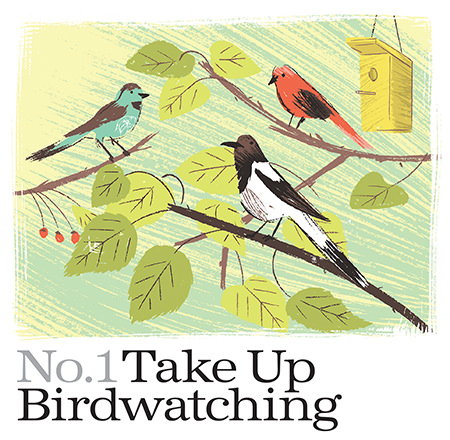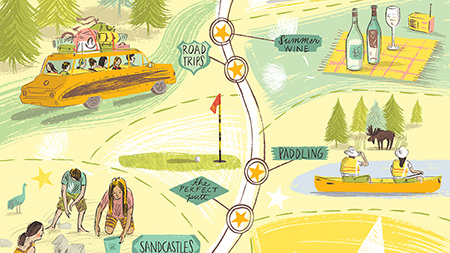By Scott Rollans on May 9, 2014; illustrations by Katy Dockrill

OK, so you can tell a magpie from a chickadee. This summer, why not spread your wings and become a backyard expert on some other feathered friends?
Ludwig Carbyn, '67 MSc, adjunct professor in the U of A Department of Renewable Resources, owns the Wildbird General Store in Edmonton with his wife, Jaynne Carre. "I never realized until we owned the store how many people, from all walks of life, are into birding," says Carbyn.
It's an easy club to join. "Start out with binoculars, a field guide, and pencil and paper for a list," Carbyn says.
"Then, just start listing what you see. You'll find that some birds are very easy to identify, and some are a little more difficult."
While bird identification apps are becoming ever more popular, Carbyn still prefers a good book, such as Peterson Field Guide to Birds of North America by Roger Tory Peterson.
With a field guide, you can quickly identify a specific bird based on geographical distribution, the bird's general appearance and specific markings.
Once you get to know your local birds, you can take your hobby with you wherever you go. "There are some 10,000 different species around the world, so you'll never get them all," says Carbyn.
Still, by adding species one by one, you'll expand your awareness of the world around you.
"Your senses become more alert because you're always listening and looking."
Great Birding Destinations
Oak Hammock Marsh Interpretive Centre
Where: A 20-minute drive north of Winnipeg
What you'll see: Waterfowl, of course, because it's a marsh, but the centre says it has hosted more than 300 species of birds.
When to go: Be there for the Summer Bird Census, June 22, or attend the Dragonfly Festival, Aug. 16 and 17.
Info: oakhammockmarsh.ca
Lesser Slave Lake Bird Observatory
Where: A 21⁄2-hour drive north of Edmonton
What you'll see: Because of the area's geography, birds - especially songbirds - tend to funnel past Marten Mountain and over the shoreline of Lesser Slave Lake.
When to go: Take in the Songbird Festival May 31 and June 1, with plenty of kid-friendly activities.
Info: lslbo.org
Long Point Bird Observatory
Where: A 21⁄2-hour drive southeast of Toronto
What you'll see: Of the 600 or so bird species in North America, nearly 380 have been recorded at the observatory.
When to go: Migrations peak in May and September. If you go between late August and October, you might also be able to see the monarch butterfly migration, since Long Point is one of three International Monarch Butterfly Reserves in Canada.
Info: birdscanada.org/longpoint/
